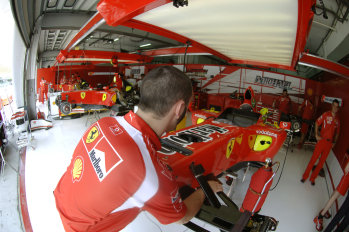|
Before one
considers that Malaysia will provide the first test of
running a V8 engine for two race weekends, there is a
further element of uncertainty from the fact that this year,
the Sepang event follows on from the heat of Bahrain,
whereas in the past it came after the relative cool of
Melbourne.
"Even for a single race in hot conditions, the cooling of
the car has to be powerful enough to ensure the engine runs
within the right temperature range," comments Scuderia
Ferrari Marlboro's head of race engines Mattia Binotto. The
main consideration is not the fact that we have two
consecutive hot races, but how good is the engine cooling
overall. If you have any problems in the area of car cooling
then you will suffer in dramatic fashion as, to do this
twice in a row makes for very hard useage. If you have a
cold race following a hot one then you can try and protect
the engine at the first race, knowing you can push it harder
in the second race. But we now face a situation where we
could exceed the cooling limits in both events."
A further consideration is that these first two races are
just one week apart. which means there is no time to react
and to effect some changes to improve cooling if it is found
to be insufficient. "Fortunately, both our cars ran reliably
in Bahrain," adds Binotto. "Normally, if the need arises,
you can always open up vents on the car to improve cooling,
but this means the aerodynamic efficiency of the car will be
dramatically reduced. So, improving cooling is usually a
long and complicated task based on work in the wind tunnel
followed by extensive testing on the track. If we have any
cooling issues now, all we can do in the very short space of
time is to go for a basic solution of more holes in the
bodywork, or protecting the engine in different ways, such
as reducing the revs. But all these solutions reduce the
speed of the car."
In Malaysia, temperatures and humidity levels will be higher
than in Bahrain, therefore cooling will be more difficult.
So all the teams can expect to face a stiffer challenge
there. While it is true that the V8 engine theoretically
requires less cooling than a V10, the F1 designers see this
as a means to making a car survive with smaller radiators so
there is still a need to fine tune this cooling.
|
 |
|
Felipe Massa during last weekend's Bahrain Grand
Prix: now Malaysia will provide the first test of
running a V8 engine for two race weekends while
there is a further element of uncertainty from the
fact that this year, the event follows straight on
from the heat of Bahrain. |
|
|
 |
|
The Scuderia Ferrari
mechanics busy setting up the pit garage in Malaysia
earlier today:
"Even for a single race in hot conditions, the
cooling of the car has to be powerful enough to
ensure the engine runs within the right temperature
range," comments the head of race engines, Mattia
Binotto. |
|
|
"Of course, you
have to think about the requirements of the hot race venues
at the stage when you are designing the car," adds Mattia
Binotto. "But with winter testing taking place mainly at
European tracks with cool temperatures, Bahrain and Malaysia
are the first real tests of running in the heat, even if
Ferrari did come to Sakhir in February, when it was just a
bit cooler than it was for the first race of the season."
However, there are further cooling complications specific to
this new engine. As the V8 is less powerful than the V10,
especially at this early stage in its development, the
drivers will be using its maximum power more often than with
the V10. "This is a very important point in terms of engine
reliability," agrees Binotto. "The increased amount of time
for full throttle opening is around 10% compared to last
year. Each cylinder is similar in size to last year's with
the V10, as although we now have eight cylinders, because of
the capacity reduction the actual cylinder size is very
similar. The rpm average per lap has also increased
considerably, because the engine is revving higher while the
driver uses full power more often."
Vibration is another key characteristic of a V8 engine. "It
does vibrate considerably, however, in theory we are allowed
to change all the ancillaries of the engine that might be
damaged by these vibrations," confirms our engine
specialist. "So this weekend is a step into the unknown,
because whatever you have done on the dyno or on the track
in winter testing, the actual race weekend environment is
always a bit different."
Finally, while the wellbeing of an engine can be preserved
through cooling radiators, it can also be protected from
within through the science of its lubricants. "We have
worked closely with Shell to optimise the way we protect the
engine in terms of its fuels and lubricants and in the case
of the lubricant itself we have done a great job in terms of
increasing the performance of the engine," concludes Binotto.
"Friction is one of the most important points in terms of
improving performance and, with the V8, that factor is now
more important than in the past. We did a really good job in
this area over the winter. The lubricant we have today has
been correctly tuned and is a big step forward compared to
what we had before. And we have more new products on the way
in this continuous joint development programme between us
and Shell."
|
|
|
|
![]()
![]()